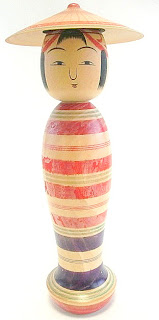The Origin of Kokeshi_1
What's the matter with "the Origin of Kokeshi?
[kokeshi description]
- artisan : Tsunehiko Watanabe
- type : Traditional Tsuchiyu
- tall : 20cm(8inch)
- max width : 8cm(3inch)
"The origin of kokeshi" - this topic had been very often argued among many people - not only kokeshi manias but also historians or folklorists in Japan and even in some other countries.Of-course,it remains unanswered,but it seems almost disappearing as kokeshi are losing their popularity.
At first,I couldn't understand the point of the argument.
While there had been many "something traditional" in Japan,why had this topic especially been argued -even among historians or folklorists?I'm also interested in some of other Japanese traditional wood crafts,but I have never heard such heated arguments about their origins like those about kokeshi's origin while some of them still remains unclear.
To begin with,what does the word "THE ORIGIN" refer to?If you are asked "who are your origin?",you can reply any answers - "the scion of a Roman aristocracy","the descendant of monkey","from mother and father" - although these are extreme rhetoric,I have often seen this kind of confused arguments in some books about kokeshi.
Anyway,what of the topic had attracted even historians or folklorists? I think there are three main factors.
- kokeshi has no limbs
- kokeshi had been made with rokuro
- kokeshi had originally been made in Tohoku,north-east region in Japan
Kokeshi as "Heteromorphous" Doll
"Why do kokeshi have no limbs?"I think anyone who have any interest in kokeshi must wonder about it - although I have read many books about kokeshi,I have never met such books that dealt with the question directly -except one book,"Looking for the lost".
There were two main approaches to its mystery -One was sociological,and another was economic.
Cultural anthropologist or folklorists (or some psychologists) often focus their attention on "something unusual" in a community -such as odd customs,taboos and so on - from their own views.
It is because such something unusual can often be the keys to veiled history or social structure or mass mentality.They tried to find "the reason why the people accepted them".And kokeshi - dolls with no limbs - were one of "something unusual".
That is,as for them,"the origin of kokeshi" meant "the reason why the people accepted such "heteromorphous",doll with abnormal shape or structure.
Alan Booth,the author of "Looking for the lost" interpreted them as "fetish substitutes".I'll introduce his opinion.
At that time,Tohoku region was so heavily-impoverished that the people could not afford to raise their kids,so they killed their babies after birth.Therefore,
"these cute,tender-faced little dolls,made from two simple pieces of wood,a sphere for the head and a cylinder for the body,may in origin have been fetish substitutes for children murdered at birth."(*1)
"The absence of limbs might be disquieting,I suppose,if you had made the possible connection between kokeshi and child murder and had read Mrs.Suzuki's account of a midwife's attempt to quicken a death by wrapping an infant tightly in rags so that its arms were bound invisibly to its sides,or if you knew that one of the traditional attributes of Japanese ghosts is that they have no feet".(*1)
I really respect his straight analysis,but I can't say yes to his opinion because there is no found tangible evidences such as old records,oral legends,or customs about it.
And in addition,why had kokeshi been sold narrowly at onsen(hot spa) spots ? - as I mentioned on the previous posts(cf."traditional kokeshi"),they had been made and sold in the deep of the mountains as souvenir.Of-course,it is possible that kokeshi were originally made as such fetish substitutes and later they changed into souvenir by loss of the initial intention.But if so,they needed to be made in a little more wider range of areas so that the custom of fetish substitutes took root? Or,conversely,there was originally another dolls which anyone could make for fetish substitutes or their babies'soul,and later they changed into kokeshi as they are today? - if so,we have to find such dolls,and they are truly "the origin of kokeshi".
I think it is possible because it is a fact that the people of the day killed their babies due to their heavy poorness in Japan.I read an article that some village in Tohoku had the custom that parent held a memorial service to make a small room and offer candies or sweets or toys for their dead kids -including killed babies by them - although the report didn't note there were kokeshi provided.
But I can't conclude it without any clear evidences.So,I'll talk another opinion of "the reason why the people accepted such odd dolls" next time.
(*1)Alan Booth,"Looking for the Lost,P129,Kodansha America,Inc.1996"
(*2)Ibid.,P130"


